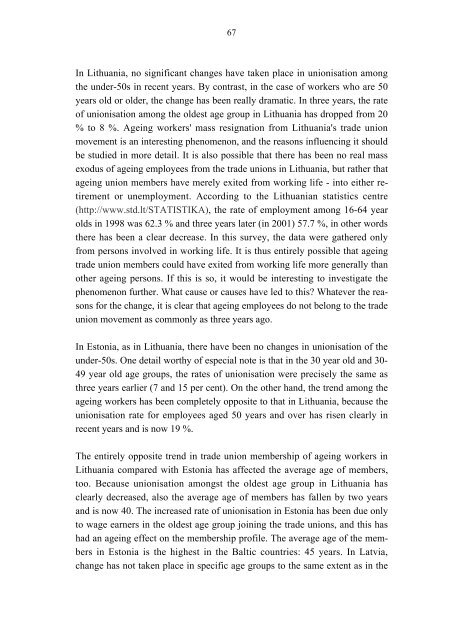Working Life Barometer in the Baltic Countries 2002 (pdf) - mol.fi
Working Life Barometer in the Baltic Countries 2002 (pdf) - mol.fi
Working Life Barometer in the Baltic Countries 2002 (pdf) - mol.fi
You also want an ePaper? Increase the reach of your titles
YUMPU automatically turns print PDFs into web optimized ePapers that Google loves.
67<br />
In Lithuania, no signi<strong>fi</strong>cant changes have taken place <strong>in</strong> unionisation among<br />
<strong>the</strong> under-50s <strong>in</strong> recent years. By contrast, <strong>in</strong> <strong>the</strong> case of workers who are 50<br />
years old or older, <strong>the</strong> change has been really dramatic. In three years, <strong>the</strong> rate<br />
of unionisation among <strong>the</strong> oldest age group <strong>in</strong> Lithuania has dropped from 20<br />
% to 8 %. Age<strong>in</strong>g workers' mass resignation from Lithuania's trade union<br />
movement is an <strong>in</strong>terest<strong>in</strong>g phenomenon, and <strong>the</strong> reasons <strong>in</strong>fluenc<strong>in</strong>g it should<br />
be studied <strong>in</strong> more detail. It is also possible that <strong>the</strong>re has been no real mass<br />
exodus of age<strong>in</strong>g employees from <strong>the</strong> trade unions <strong>in</strong> Lithuania, but ra<strong>the</strong>r that<br />
age<strong>in</strong>g union members have merely exited from work<strong>in</strong>g life - <strong>in</strong>to ei<strong>the</strong>r retirement<br />
or unemployment. Accord<strong>in</strong>g to <strong>the</strong> Lithuanian statistics centre<br />
(http://www.std.lt/STATISTIKA), <strong>the</strong> rate of employment among 16-64 year<br />
olds <strong>in</strong> 1998 was 62.3 % and three years later (<strong>in</strong> 2001) 57.7 %, <strong>in</strong> o<strong>the</strong>r words<br />
<strong>the</strong>re has been a clear decrease. In this survey, <strong>the</strong> data were ga<strong>the</strong>red only<br />
from persons <strong>in</strong>volved <strong>in</strong> work<strong>in</strong>g life. It is thus entirely possible that age<strong>in</strong>g<br />
trade union members could have exited from work<strong>in</strong>g life more generally than<br />
o<strong>the</strong>r age<strong>in</strong>g persons. If this is so, it would be <strong>in</strong>terest<strong>in</strong>g to <strong>in</strong>vestigate <strong>the</strong><br />
phenomenon fur<strong>the</strong>r. What cause or causes have led to this? Whatever <strong>the</strong> reasons<br />
for <strong>the</strong> change, it is clear that age<strong>in</strong>g employees do not belong to <strong>the</strong> trade<br />
union movement as commonly as three years ago.<br />
In Estonia, as <strong>in</strong> Lithuania, <strong>the</strong>re have been no changes <strong>in</strong> unionisation of <strong>the</strong><br />
under-50s. One detail worthy of especial note is that <strong>in</strong> <strong>the</strong> 30 year old and 30-<br />
49 year old age groups, <strong>the</strong> rates of unionisation were precisely <strong>the</strong> same as<br />
three years earlier (7 and 15 per cent). On <strong>the</strong> o<strong>the</strong>r hand, <strong>the</strong> trend among <strong>the</strong><br />
age<strong>in</strong>g workers has been completely opposite to that <strong>in</strong> Lithuania, because <strong>the</strong><br />
unionisation rate for employees aged 50 years and over has risen clearly <strong>in</strong><br />
recent years and is now 19 %.<br />
The entirely opposite trend <strong>in</strong> trade union membership of age<strong>in</strong>g workers <strong>in</strong><br />
Lithuania compared with Estonia has affected <strong>the</strong> average age of members,<br />
too. Because unionisation amongst <strong>the</strong> oldest age group <strong>in</strong> Lithuania has<br />
clearly decreased, also <strong>the</strong> average age of members has fallen by two years<br />
and is now 40. The <strong>in</strong>creased rate of unionisation <strong>in</strong> Estonia has been due only<br />
to wage earners <strong>in</strong> <strong>the</strong> oldest age group jo<strong>in</strong><strong>in</strong>g <strong>the</strong> trade unions, and this has<br />
had an age<strong>in</strong>g effect on <strong>the</strong> membership pro<strong>fi</strong>le. The average age of <strong>the</strong> members<br />
<strong>in</strong> Estonia is <strong>the</strong> highest <strong>in</strong> <strong>the</strong> <strong>Baltic</strong> countries: 45 years. In Latvia,<br />
change has not taken place <strong>in</strong> speci<strong>fi</strong>c age groups to <strong>the</strong> same extent as <strong>in</strong> <strong>the</strong>

















